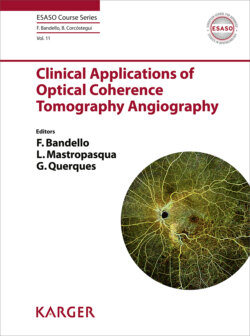Читать книгу Clinical Applications of Optical Coherence Tomography Angiography - Группа авторов - Страница 12
На сайте Литреса книга снята с продажи.
Classification of AMD
ОглавлениеClinically, AMD is classified into three categories: early, intermediate, and late AMD. Normal aging may involve the formation of a few drusen, less than 63 μm in size, between the RPE and Bruch’s membrane, which have not been shown to increase the risk of development of AMD [10]. Drusen consist of hydrophobic extracellular focal deposits of lipofuscin, photoreceptor debris, and inflammatory components [11, 12]. Early AMD is characterized by drusen between 63 and 125 µm in size with no pigmentary changes. Pigmentary abnormalities, due to RPE alterations, or larger-sized drusen, at greater than 125 µm, indicate progression to intermediate AMD [13]. Overall, drusen size is an important predictive marker, as small drusen less than 63 µm are unlikely to progress to late AMD [13]. The risk of developing late AMD increases with increasing drusen size [14]. The development of neovascularization and/or geographic atrophy (GA) defines late AMD. GA, still under the umbrella of dry AMD, is characterized by subretinal drusen and loss of photoreceptors, RPE, and choriocapillaris (CC). Atrophy is usually confined to a particular region, hence the term “geographic atrophy,” and often a clear-cut boundary between affected RPE and adjacent normal, unaffected RPE may be visualized. GA has also been associated with outer retinal changes and atrophy and alteration of choroidal vessels [15, 16]. The presence of neovascularization in late AMD is often referred to as exudative, or wet, AMD.
Overall, both wet AMD and dry AMD are associated with poor visual outcomes. While wet AMD accounts for only 10% of patients with AMD, it is the reason for 90% of AMD-related blindness. The advent of intravitreal anti-vascular endothelial growth factor (VEGF) injections has revolutionized the treatment of wet AMD, greatly improving visual outcomes [17, 18]. However, it has been questioned whether anti-VEGF injections result in the progression to outer retinal and macular atrophy [9, 19].
